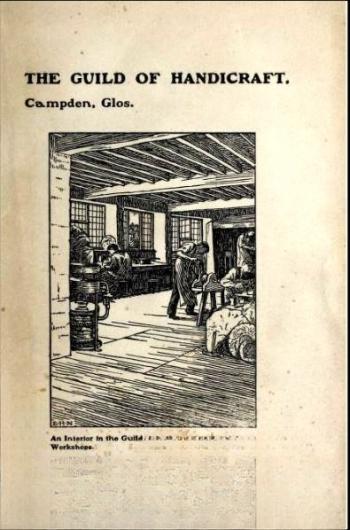Guild of Handicraft
Toynbee Hall School and Guild of Handicraft was the original name of the Guild and School of Handicraft founded by Charles Robert Ashbee in 1888 at Toynbee Hall, a settlement community in the East End of London where he was in residence. The enterprise relocated to workshops at Essex House on the Mile End Road, in London's East End in c.1889, by which time it had dropped Toynbee Hall from its name. Over the next few years, many Guilds were formed and these included
Birmingham Guild of Handicraft (Birmingham Guild Ltd.)
The Birmingham Guild was established in 1890, its founder member being Arthur Stansfield Dixon. It originated as a semi-autonomous group with the Birmingham Kyrle Society. By 1895 the Guild had formed an independent workshop and became a limited company. Circa 1894 the Guild began producing books under the imprint ‘The Birmingham Guild of Handicraft Press’. The press was founded by Arthur Dixon, Montague Fordham, (1864-1948) and Claude Napier Clavering with the advice and help of Emery Walker. It aimed to improve the standards of commercial printing which it did to great effect. Designers and artists associated with the Press included Arthur J. Gaskin, Mary Newill and Charles March Gere. The Press ceased to function in 1919, however, the Birmingham Guild was active until the 1950's. This Guild was closely aligned with the Birmingham Group of Artist-Craftsmen.
The Guild was closely associated with the Birmingham School of Art, many of the designers and craftspeople who worked for the company either trained or taught at the School. The motto of the Guild was 'By Hammer and Hand'. Its activities included furniture-making, publishing, and the production of art metalware and jewellery. The latter was the most successful and longest-lived. Arthur Stansfield Dixon was the chief designer of the metalwork shop. Other designers associated with the shop included Albert Edward Jones,(1878-1954), George T. Tarling, Claude Napier Clavering, Charles Llewellyn Roberts, and Thomas Birkett. The Guild participated in the exhibitions of the Arts and Crafts Exhibition Society in London in 1893, 1896, 1899, 1903 and 1906. Work by the Guild was also shown in the 1st Exhibition of the Arts and Crafts Society of Ireland in 1895, the Second Exhibition of Arts and Crafts at Manchester City Art Gallery in 1895, the Arts and Crafts Exhibition at Knight & Forster in Leeds in 1900, and in the British Arts & Crafts Section of the International Exhibition in Ghent in 1913. The Guild was never particularly large, at its peak in the late 1890's it employed about 19 workers.
Clarion Guild of Handicraft
This Guild was established by the socialist writer and theorist Robert Blatchford (1851-1943) in 1901. Unlike other craft guilds, it did have not a single workshop but was a federation consisting of a mass of amateur craftsmen and craftswomen who were co-ordinated through Blatchford’s eponymous newspaper ‘Clarion'. The Guild held its first exhibition in Liverpool in 1901.
Mercian Guild of Handicraft
The Mercian Guild was founded in the 1890's or early 1900's in Stoke-upon-Trent. It produced furniture, pottery, metalwork, enamels, jewellery and embroidery. Designers who worked for the Guild included F. Rhead, L. Rhead, H. Rhead, J. Mayer, F. Loffil, W. Murray, J. Barclay, and M. Turner. The Guild probably disbanded c.1904.
Scottish Guild of Handicraft
The Scottish Guild was established in Glasgow, Scotland in 1898 and was modelled on C.R. Ashbee’s Guild of Handicraft founded in Whitechapel, London, a decade earlier. By 1900 the Scottish Guild had acquired a shop and gallery space at 414 Sauchiehall Street, Glasgow and in 1903 it was formally registered under the Industrial and Provident Societies Act. The Guild took the form of a cooperative society. Each of the members held shares in the enterprise which was run by a committee. Among the many craftspeople and designers who belonged to the Guild were Annie French, Ann Macbeth, Jessie M. King, John W. Bennett, John C. Hall, William McWhannel Petrie, E.A. Taylor, Jessie Keppie, Kellock Brown, Phoebe Traquair, Henry T. Wyse, P. Wylie Davidson, John Ednie, Helen Paxton Brown and Robert MacLaurin,(1871-1948).MacLaurin was not a craftsman in the accepted sense but was a notable Glaswegian industrial chemist who worked in many crafts in his spare time as was indicated by his business card. It referred to all members and stated that services offered included furniture, wrought metal, leaded glass, embroideries, stencilling, pottery, electric fittings, panels in gesso and friezes.
In 1906 the Guild opened workshops in Burghmuir near Perth. Guild members also had studios elsewhere in Scotland. After the move, the Guild maintained a presence in Glasgow for a while through its Arcadian Gallery on St. Vincent Street. Several examples of work by the Guild are illustrated in the Studio Yearbook of Decorative Art 1906 and 1907. Unlike Ashbee’s Guild of Handicraft, which ran into financial difficulties and was forced to close in 1907, The Scottish Guild survived until 1919.
Get Unlimited Access from just £5


